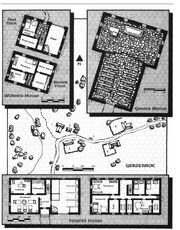
The Hamlet of Gersebroc
Gersebroc (Er."Hero's Burrow";S."Haudh-in-Callon") lay to the north of Net Riagaill along the road running to the east of the Whitbeamwood. It was a small hamlet of just 5 buildings.
Inhabitants[]
Odelard Witbert
Layout[]
1. Gerse's Shrine. This stone building had just one floor at ground level, but high walls so that inside the ceiling was lofty. It had been whitewashed inside and out and was roofed with magnificent old oak beams and wooden tiles.By TA 1649 this building was about 400 years old and had been built in a T-shape, the front portion split off from the Shrine proper by wooden screens (which could be moved against the walls if desired). The front portion was more decorated. A pair of superbly carved wooden doors depicted scenes from the most famous of Gerse's many legends. The front room had bench seating, some books (records of the area, local history, poetry and lays connected with Gerse and other Northlander heroes) and cupboards containing paraphernalia for use in services andblessings — Witbert's robes, candles, oils, etc. Behind the wooden screen (which was painted and carved with memories of Gerse on the front room side) was a bare shrine 30' long and 20' wide. At the northern end was a stone sarcophagus on a plinth. Behind it rested the Gersebroc, set in a slot in a stone dais, so that it stood upright (it could easily be removed). High windows in the side and end walls lighted the Shrine, but also made it freezing in winter. There were no seats, just cold stone flags and bare white walls. Even the wooden screen was bare on this side. There was a wooden lectern reached by four steps to the left of the tomb. Witbert addresses his congregation from here. Sometimes scented oils or candles were set around the sarcophagus and burned to lend an holy air to the place.
2. Witbert's House. The priest's house was connected to the Shrine by a covered wooden passageway. The house itself was small and built like the town houses of Net Riagaill. The priest,in TA 1640 a man named Witbert,lived here but was often absent. He had a servant housekeeper, an old woman of 70 or so. There was little of any interest in the house — his bedroom, study,the kitchen, storerooms, the servant's room, stables in the lower portion and so on. Concealed beneath a flagstone on the ground floor was a wooden chest.The chest was locked (hard) and trapped; the trap consisted of a sprung blade beside the lock (dagger attack) which was disarmed by depressing two of the rivets on the lid (very hard). Inside were 4 Gold Coins and 210 Silverpennies,Witbert's emergency funds. Concealed in a false base to the chest was a curious shortsword Witbert had probably forgotten all about. It was magical and of Silvan Elf manufacture. The sword had a 12" blade, the last 2 1/2" of which were crystal of some sort.
3. House of the Healer. About TA 1540 a woman named Odelard lived in this large and handsome villa built like the town houses. The ground floor served as the "hospital", with a "surgery", several beds close to a central hearth, and a small "apothecary" area for preparing herbs and cures. It also housed a stable and byre, but the area for animals was well-separated. Odelard kept a few pigs and chickens,a goat and a dairy cow and three horses. The house was only a few years old and looked very new still. Since Odelard was not short of money, she lived well and liked to have her house kept tidy and clean. Odelard was often absent, foraging for herbs, but at least one of her two assistants was always here, tending some patients. The assistants both had rooms on the upper floor, alongside Odelard's own room (a large and spacious room with rich furnishings), a bright day room, a small reference library and workroom, a kitchen, a bathing room and several storerooms.An extensive herb garden had been planted around the house sheltered bya stone wall, along with some fruit trees and succulent vegetable plants. Many valuable healing herbs and preparations could be found in the garden or the "apothecary" area, but no one knew where Odelard kept the remains of her fortune.
4. Farms.
5. Standing Stone. This stone was of an unnatural brown coloration, unlike any local stone. It was brought here and erected in ages past by an unknown people and for a forgotten purpose. It stood upright, 8' tall and 2-3' thick.On the east face, towards the top, it bore a star-burst engraving, but the etching was exceedingly ancient and weathered. The stone had no significance and did not detect as having any power or magical attributes
Notes[]
Gersebroc does not seem to have either northron nor halethian roots, it is possibly an untranslated Eriedaic name.The intended meaning may be "Hero's Burrow".
References[]
- MERP:Phantoms of the Northern Marches
